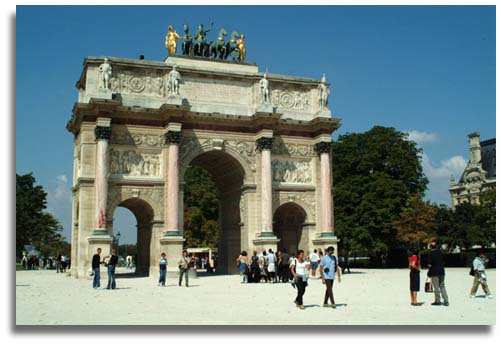
The
Tuileries
Metro : Tuileries or Concorde

Stretching from the Louvre to the Place de la Concorde, the Tuileries
gardens (Jardins des Tuileries) have long been popular with bourgeois
parisian families taking their Sunday promenade, though nowadays, the
chairs placed around the water-features are often occupied by tourists
resting after a tour of the Louvre or one of the smaller galleries in
the gardens, the Jeu de Paume and Orangerie.
Named after
the medieval warren of tilemakers that once occupied the site, the
Tuileries gradens are all that survive of the palace and grounds
commissioned by Catherine de Medicis in the mid-sixteenth century. The
palace was burnt down during the Paris Commune in 1871. Catherine took
great interest in her garden and had a maze, a chequerboard of
flowerbeds and formal vegetable gardens laid out, to be admired by
guests at her sumptuous parties. A hundred years later, le Notre, who
landscaped the grounds of Versailles, created the current schema
of the gardens, installing a central axis, terrasses, and round and
octagonal pools. Later, sculptures were brought here from Versailles
and Marly, included Coysevox's rearing horses Fama and Mercury. The
originals are now housed in the Richelieu wing of the Louvre and have
been replaced by copies.
During the eighteenth century,
fashionable parisians came to the gardens to preen and party, and in
1783, the Montgolfier brothers, Josephine and Etienne, launched the
first successful hot-air balloon here. The first serious replanting was
carried out after the revolution, and in the ninetieth century, rare
species were added to the garden, by this time dominated by chestnut
trees. Unfortunately, the December 1999 storms which ravaged northern
France, stripped the Tuileries gardens of some of its oldest trees :
the centennial chestnuts around the two central oval ponds are now the
most senior. Le Notre's original design, however, remains little
changed. In recent years, some modern sculptures have been placed
around the gardens, mostly works by Giacometti, Ernst, Moore, Raymond
Mason and a couple of colorful Solférino footbridge, which was
opened in 1999 and links the Tuileries with Musée d'Orsay on the
Left bank.








Absolutely not the same place than Studio
Marais , rue du Bourg-Tibourg,
Completely the other side of Paris from
Studio Sicile , rue du Roi de Sicile.









